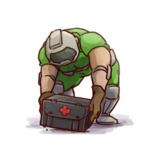Doom Travelogues 10: DoomRL
By Praxis 0 Comments
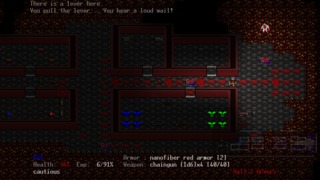
I can’t really tell you when I first came to be aware of Kornel Kisielewicz’s Doom, the Roguelike. It most certainly wasn’t in 2002, when the initial version was released, but it was definitely prior to the addition of Derek Yu’s non-ASCII graphics in 2012. Somewhere in that ten year window. Not that it matters. More to the point I haven’t had a strong desire to play it until about a week ago. I do remember twiddling around with the graphical version a couple years back, the briefest of dalliances which I think lasted all of about an hour, if that, but until recently I hadn’t devoted any serious time to it. Which I guess is weird. I mean, sure, I haven’t played any roguelikes before (and precious little of the increasingly nebulously-defined genre inspired by them, for that matter), but I like RPGs, and some of my favorite games are turn-based. Still, like an electric blanket in a rain storm, I’ve avoided roguelikes, or at least haven’t gone out of my way to play any. But if ever there was a gateway into that world tailor-made for me, DoomRL is it.
For those unawares, DoomRL is a tile-based, turn-based, no-savin’, no-foolin’ RPG (i.e., a roguelike) that mirrors the basic arc of pre-Ultimate Doom, in that there are three distinct chapters (Phobos, Deimos, Hell), each capped with a boss fight and some brief congratulatory text (if you win, natch). In this case, they’re presented contiguously, as a single 24-level dungeon, rather than episodically. There are eight levels in each “episode,” with the first seven being randomly-generated affairs, and the last a not-so-randomly-generated boss arena. In addition, there are a number of red staircases to be found that lead not to the next level of the dungeon but to optional side areas that will dump you back into the main dungeon once you’ve completed them. These side areas are typically tough challenges that are fixed rather than random (though there are exceptions), and more often than not they are interpretations of actual Doom levels.
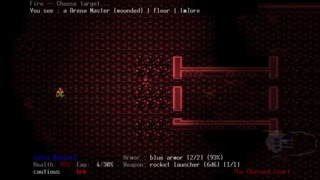
Like most RPGs, there are different character classes to choose from, though the choices here are less important than in other games. Everyone has access to the same guns and items, so your selection largely affects your starting perks and which advanced trait you can invest in without prerequisites. For my money, the Technician’s early access to Whizkid, which increases weapon modability, is hard to beat, but there really isn’t a wrong answer. You gain a trait point every level, and most traits are available to all classes. Each class has five unique “master” traits, but they cover similar specializations regardless of class (melee attacks, burst weaponry, etc.), and furthermore master traits have such specific requisites that they’re not likely to be used that often anyway. To compare it to another well-established RPG I barely understand, DoomRL’s classes are reminiscent of D&D’s character kits in that they feel like three slight variations on one class. I have to say, though, I was pretty impressed that Kisielowicz found a way to graft the standard fighter/mage/thief archetypes onto Doom in a way that doesn’t not make sense.
The main difference between DoomRL and other roguelikes, or at least what I imagine to be the main difference in the absence of any meaningful credentials in the genre, is its heavy focus on ranged combat. Melee combat is an option, of course. There are combat knives and chainsaws to facilitate this, and I’m pretty sure you could use your fists too if you really wanted to, but there’s no immediately compelling reason to do so. Enemies can fire on you the moment they see you, and will have more opportunities to harm you if you try to close the gap rather than just blasting them. In the earlier parts of the game acquiring weapons is your first order of business, a task only slightly eclipsed by staying alive. Making sure you have a well-rounded suite of armaments at your disposal is as important to success as picking the right character traits when levelling or making sure you have enough health kits and armor to take hits and keep on going.
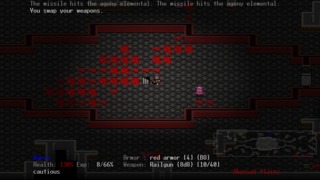
The game also features a rather extensive crafting system. As you explore you’ll come across various mod pick-ups that can be fitted into weapons and armor, thus augmenting them in one way or another. Some of these offer handy but not exactly jaw-dropping benefits, like increased accuracy or reload speed, while others are pretty dramatic. With the right mod, for instance, you can make your plasma rifle regenerate ammo or your combat armor indestructible. In addition, specific combinations of mods applied to specific items can transform the base item into one of a special class of equipment called assemblies. The game doesn’t explain how to make any of these up front, though it does keep track of the ones you’ve made, so you’ll just have to get out there and experiment. This is why I mentioned the Technician class earlier as being particularly strong. Whizkid, which allows you to mess around with mods more liberally, is available to all classes, but the Technician can get it right away, giving him lots of time to make powerful equipment. Of course, Whizkid doesn’t actively make you stronger the way that most traits do, but the potential rewards are worth it.
Once I’d wrapped my head around the game I was actually quite pleased at how similar to Doom it manages to be. For a turn-based game the combat is surprisingly punchy. Targets that were squishy in the original game are squishy here, too, so unloading a double-barreled shotgun into a crowd of zombies is apt to take all of them out. Even tougher foes like barons and mancubi go down pretty fast with the right weapons. Doom’s emphasis on player mobility makes the transition as well, which I certainly approve of. Projectile attacks can be effectively strafed and juking out of the way of an incoming lost soul is not out of the question either. As in Doom, ammo management can be very important to success, although in DoomRL’s case it’s mostly due to the fact that ammunition has to fight with everything else for a spot in your inventory. All the classic Doom enemies and power-ups are here, save for the spectre, and the combination of Derek Yu’s artwork, id’s sound effects, and some remixed Doom tracks helps set the tone.
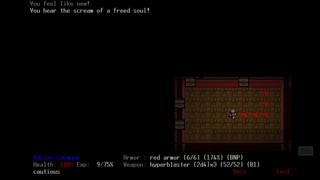
I originally tried the game out on Hurt Me Plenty, since higher difficulties have to be unlocked by achieving specific milestones. After about thirty attempts with varying degrees of success I switched over to Hey, Not Too Rough and promptly beat the game on my third try. In retrospect, HNTR is clearly the baseline difficulty and the way in which you’re meant to familiarize yourself with DoomRL in preparation for higher difficulties. The challenge ramps up far more gradually than HMP, to the point where, at times, I was having to discard health packs, something I can’t recall doing previously. Both of my deaths in HNTR felt like the direct result of my own stupidity, whereas many of my deaths in HMP seemed to result from bad readings on the rand-o-meter. But that’s the appeal, I guess, being savvy enough and having built up enough of a buffer that you can survive even the most heinous random encounters the game can throw at you. I guess I was just surprised that HNTR never hits below the belt when HMP does so with gusto.
So in short, I really enjoyed DoomRL, and would not be opposed to playing more of it in the future. According to the player info screen, I achieved the “standard” ending as opposed to the “full” ending, which implies some sort of optional boss encounter I have yet to discover. I also skipped some of the side areas and avoided using a lot of the weirder items I encountered for fear of prematurely ending my run, so there’s a lot of stuff left to explore, and less pressure now that I’ve cleared it once. Then there’s the challenge mode that I have yet to look into. Between all the item customization, the dungeon randomization, and the higher difficulties, it seems like a game with a lot of longevity to it, and one that I’m glad I gave another go. It manages to earn its appropriation of the Doom franchise instead of simply using it for nostalgia’s sake. Consider me officially intrigued to see what happens with Jupiter Hell, the potentially-Kickstarter-funded commercial spiritual sequel to DoomRL (and also AliensRL) that Kisielowicz has been teasing since last year.
